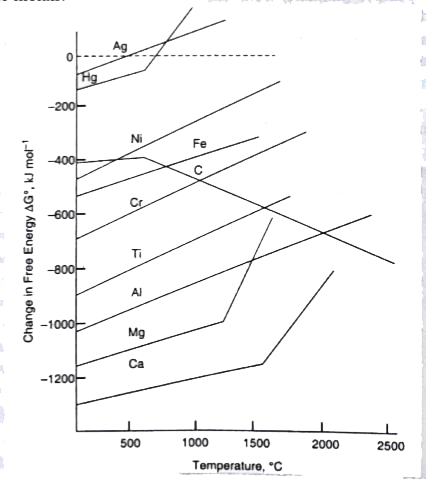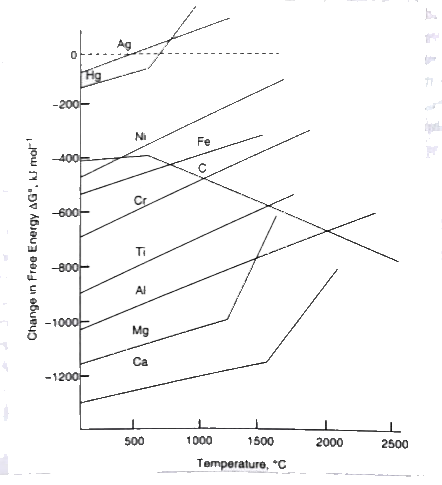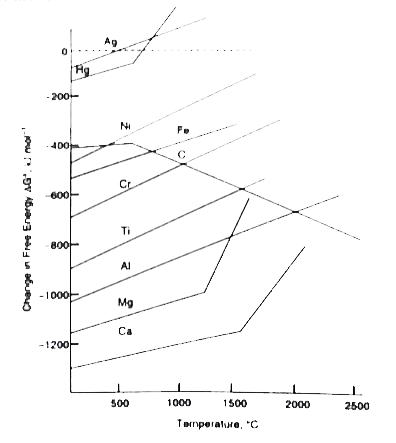For metal oxides, when ΔG∘ is poltted against temperature, there is a point where the graph crosses ΔG -zero line, above this temperature
the oxide is stable
the oxide is unstable
the oxide melts
the oxide is reduced.
The correct Answer is:B
The graph which represents the variation of standard free energy with temperature for the formation of oxides of elements is called Ellingham diagram. In case of certain metals, the graph rises and free energy of formation becomes greater than zero at high temperatures. So these metal oxides are unstable at higher temperatures, for example silver oxide and mercury oxide
Topper's Solved these Questions
- GENERAL PRINCIPALS AND PROCESSES OF ISOLATION OF ELEMENTSBook:MTG GUIDEChapter:GENERAL PRINCIPALS AND PROCESSES OF ISOLATION OF ELEMENTSExercise:Check Your NEET/VITALS
Explore 1 Video
- GENERAL PRINCIPALS AND PROCESSES OF ISOLATION OF ELEMENTSBook:MTG GUIDEChapter:GENERAL PRINCIPALS AND PROCESSES OF ISOLATION OF ELEMENTSExercise:Check Your NEET/ITALS
Explore 24 Videos
- GENERAL PRINCIPALS AND PROCESSES OF ISOLATION OF ELEMENTSBook:MTG GUIDEChapter:GENERAL PRINCIPALS AND PROCESSES OF ISOLATION OF ELEMENTSExercise:AIPMT/NEET (MCQs)
Explore 10 Videos
- ELECTROCHEMISTRYBook:MTG GUIDEChapter:ELECTROCHEMISTRYExercise:AIPMT/NEET(MCQs)
Explore 5 Videos
- HALOALKANES AND HALOARENES Book:MTG GUIDEChapter:HALOALKANES AND HALOARENES Exercise:AIMPT/NEET
Explore 10 Videos
Similar Questions
For a sponaneous reaction, the free energy change must be negative, ΔG=ΔH−TΔS,ΔH is the enthalpy change during the reaction. T is the absolute temperature, and ΔS is the change in entropy during the reaction. Consider a reaction such as the formation of an oxide
M+O2→MO
Dioxygen is used up in the course of this reaction. Gases have a more random structure (less ordered) than liquid or solids. Consequently gases have a higher entropy than liquids and solids. In this reaction S (entropy or randomness) decreases, hence ΔS is negative. Thus, if the temperature is raised then TΔS becomes more negative,Since, TΔS is substracted in the equation, then ΔG becomes less negative. Thus, the free energy change increases with the increase in temperature.
The free energy changes that occur when one mole of common reactant (in this case dioxygen) is used may be plotted graphically aginst temperature for a number of reactions of metals to their oxides. The following plot is called an Ellingham diagram for metal oxide. Understanding of Ellingham diagram is extremely important for the efficient extraction of metals.

Free energy change of Hg and Mg for the convertion to oxides the slpe of ΔG vsT has been changed above the boiling points of the given metal because :
View SolutionΔH and ΔS for the reaction:
Ag2O(s)→2Ag(s)+(1/2)O2(g)
are 30.56kJmol−1 and 66.0JJK−1mol−1 respectively. Calculate the temperature at which free energy change for the reaction will be zero. Predict whether the forward reaction will be favoured above or below this temperature.
View Solution
Knowledge Check
Assertion. The reduction of a metal oxide is easier if the metal formed is in the liquid state.
Reason. ΔfG∘ of metal oxides increases with temperature.AIf both assertion and reason are true, and reason is not the true explanation of the assertion.BIf both assertion and reason are true, but reason is not the true explanation of the assertion.CIf assertion is true, but reason is falseDIf both assertion and reason are falseFor a sponaneous reaction, the free energy change must be negative, ΔG=ΔH−TΔS,ΔH is the enthalpy change during the reaction. T is the absolute temperature, and ΔS is the change in entropy during the reaction. Consider a reaction such as the formation of an oxide
M+O2→MO
Dioxygen is used up in the course of this reaction. Gases have a more random structure (less ordered) than liquid or solids. Consequently gases have a higher entropy than liquids and solids. In this reaction S (entropy or randomness) decreases, hence ΔS is negative. Thus, if the temperature is raised then TΔS becomes more negative,Since, TΔS is substracted in the equation, then ΔG becomes less negative. Thus, the free energy change increases with the increase in temperature.
The free energy changes that occur when one mole of common reactant (in this case dioxygen) is used may be plotted graphically aginst temperature for a number of reactions of metals to their oxides. The following plot is called an Ellingham diagram for metal oxide. Understanding of Ellingham diagram is extremely important for the efficient extraction of metals.

Free energy change of Hg and Mg for the convertion to oxides the slpe of ΔG vsT has been changed above the boiling points of the given metal because :Aabove the boiling point of the metal entropy is increasedBabove the boiling point of the metal the entropy is decreasedCabove the boiling point of the metal the entropy change is equal to zeroDAll of these
The points noted by arrows are melting and boiling points of the metal zinc and magnasium. ΔG0 as a function of temperature for some reaction of extractive metallurgy.
At what approximate temprature, zinc and carbon have equal affinity for oxygen?A1000∘CB1500∘CC500∘CD1200∘C
For a sponaneous reaction, the free energy change must be negative, ΔG=ΔH−TΔS,ΔH is the enthalpy change during the reaction. T is the absolute temperature, and ΔS is the change in entropy during the reaction. Consider a reaction such as the formation of an oxide
M+O2→MO
Dioxygen is used up in the course of this reaction. Gases have a more random structure (less ordered) than liquid or solids. Consequently gases have a higher entropy than liquids and solids. In this reaction S (entropy or randomness) decreases, hence ΔS is negative. Thus, if the temperature is raised then TΔS becomes more negative,Since, TΔS is substracted in the equation, then ΔG becomes less negative. Thus, the free energy change increases with the increase in temperature.
The free energy changes that occur when one mole of common reactant (in this case dioxygen) is used may be plotted graphically aginst temperature for a number of reactions of metals to their oxides. The following plot is called an Ellingham diagram for metal oxide. Understanding of Ellingham diagram is extremely important for the efficient extraction of metals.

Which of the following elements can be prepared by heating the oxide above 400∘C ?
View SolutionFor a sponaneous reaction, the free energy change must be negative, ΔG=ΔH−TΔS,ΔH is the enthalpy change during the reaction. T is the absolute temperature, and ΔS is the change in entropy during the reaction. Consider a reaction such as the formation of an oxide
M+O2→MO
Dioxygen is used up in the course of this reaction. Gases have a more random structure (less ordered) than liquid or solids. Consequently gases have a higher entropy than liquids and solids. In this reaction S (entropy or randomness) decreases, hence ΔS is negative. Thus, if the temperature is raised then TΔS becomes more negative,Since, TΔS is substracted in the equation, then ΔG becomes less negative. Thus, the free energy change increases with the increase in temperature.
The free energy changes that occur when one mole of common reactant (in this case dioxygen) is used may be plotted graphically aginst temperature for a number of reactions of metals to their oxides. The following plot is called an Ellingham diagram for metal oxide. Understanding of Ellingham diagram is extremely important for the efficient extraction of metals.

For the conversion of Ca(s) to Ca(s) which of the following represent the ΔG vs. T ?
View SolutionQuestion given below are based on the given diagram of extractive metallurgy.

The point noted by arrow are the melting and boiling points of the metals zinc and magnesium. ΔG∘ as a function of temperature for some reaction of extractive metallurgy.
At what temperature, zinc and carbon have equal affinity for oxygen?
View SolutionFor a sponaneous reaction, the free energy change must be negative, ΔG=ΔH−TΔS,ΔH is the enthalpy change during the reaction. T is the absolute temperature, and ΔS is the change in entropy during the reaction. Consider a reaction such as the formation of an oxide
M+O2→MO
Dioxygen is used up in the course of this reaction. Gases have a more random structure (less ordered) than liquid or solids. Consequently gases have a higher entropy than liquids and solids. In this reaction S (entropy or randomness) decreases, hence ΔS is negative. Thus, if the temperature is raised then TΔS becomes more negative,Since, TΔS is substracted in the equation, then ΔG becomes less negative. Thus, the free energy change increases with the increase in temperature.
The free energy changes that occur when one mole of common reactant (in this case dioxygen) is used may be plotted graphically aginst temperature for a number of reactions of metals to their oxides. The following plot is called an Ellingham diagram for metal oxide. Understanding of Ellingham diagram is extremely important for the efficient extraction of metals.

Which of the following elements can be prepared by heating the oxide above 400∘C ?
View SolutionFor a sponaneous reaction, the free energy change must be negative, ΔG=ΔH−TΔS,ΔH is the enthalpy change during the reaction. T is the absolute temperature, and ΔS is the change in entropy during the reaction. Consider a reaction such as the formation of an oxide
M+O2→MO
Dioxygen is used up in the course of this reaction. Gases have a more random structure (less ordered) than liquid or solids. Consequently gases have a higher entropy than liquids and solids. In this reaction S (entropy or randomness) decreases, hence ΔS is negative. Thus, if the temperature is raised then TΔS becomes more negative,Since, TΔS is substracted in the equation, then ΔG becomes less negative. Thus, the free energy change increases with the increase in temperature.
The free energy changes that occur when one mole of common reactant (in this case dioxygen) is used may be plotted graphically aginst temperature for a number of reactions of metals to their oxides. The following plot is called an Ellingham diagram for metal oxide. Understanding of Ellingham diagram is extremely important for the efficient extraction of metals.

For the conversion of Ca(s) to Ca(s) which of the following represent the ΔG vs. T ?
View Solution
